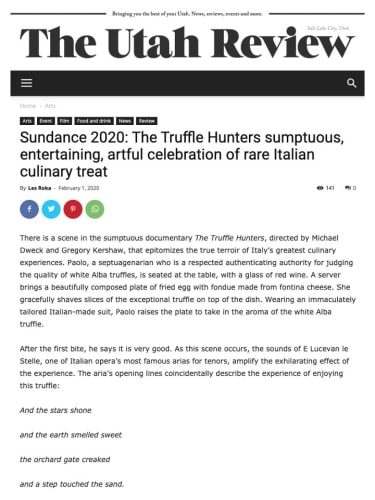The Truffle Hunters sumptuous, entertaining, artful celebration of rare Italian culinary treat
The Utah Review
02/01/2020
Back
By Les Roka
There is a scene in the sumptuous documentary The Truffle Hunters, directed by Michael Dweck and Gregory Kershaw, that epitomizes the true terroir of Italy’s greatest culinary experiences. Paolo, a septuagenarian who is a respected authenticating authority for judging the quality of white Alba truffles, is seated at the table, with a glass of red wine. A server brings a beautifully composed plate of fried egg with fondue made from fontina cheese. She gracefully shaves slices of the exceptional truffle on top of the dish. Wearing an immaculately tailored Italian-made suit, Paolo raises the plate to take in the aroma of the white Alba truffle.
After the first bite, he says it is very good. As this scene occurs, the sounds of E Lucevan le Stelle, one of Italian opera’s most famous arias for tenors, amplify the exhilarating effect of the experience. The aria’s opening lines coincidentally describe the experience of enjoying this truffle:
And the stars shone
and the earth smelled sweet
the orchard gate creaked
and a step touched the sand.
She came in, fragrant,
And fell into my arms.
These truffles, exclusively found in the Piedmont region of northern Italy, normally command prices of between $6,000 and $10,000 per pound. In the film, an auction for this extraordinary delicacy is shown. The going price: $110,000.
However, the true heroes of this magnificent documentary, which echoes the stylistic effects of a masterwork by Caravaggio, Titian or Rembrandt (an effect that Dweck and Kershaw aimed toward), are the elderly men, accompanied by their dogs, who hunt for these rare delicacies during the ideal season that lasts from September through early January.
They are unforgettable characters. Indeed, they are gentlemen but they also jealously guard the secrets, territory and practices of the work they have accomplished throughout their long lives. They do not even their trade secrets with family members. Their most trusted companions in their work are their beloved dogs. On the other, it is suggested that they would resort to any means to protect the proprietary features of their work – and that includes poisoning the dogs belonging to rival truffle hunters.
The directors, who last appeared in Sundance two years ago with the documentary The Last Race, develop a portrait of this unique community in scrupulous detail. It took three years of filming in the Piedmont region villages of Santo Stefano Belbo, Monforte d’Alba and Roddino. It is a part of the world that has nearly escaped every vestige of the 21st century. Single-frame shots accentuate the classic painting effect. It is a tribute to the images and sounds we have come to associate with Italy’s quintessential historical character.
There also are clips of exhilarating footage from the dogs’ perspective during the hunt, achieved by strapping customized miniature camera harnesses around their heads which also were fitted with lavalier microphones. The viewer hears the sniffing and digging sounds that round out an already extraordinary portrait.
The venerable human characters are fascinating in their eccentricities, which they leverage for their strategic value. The oldest is Carlo, 88, who ignores his wife’s insistent pleas to stop hunting especially during the nighttime hours. In one scene, he climbs gingerly out the window, careful not to be noisy or otherwise his wife will wake up. His dog, Titina, is ready to go. Carlo sees his work as his spiritual vocation, one endorsed by a local Catholic priest, a statement which delights the old man. Aurelio, 84, who has no heirs, stubbornly refuses to share the secrets of his trade with younger hunters. His most trusted companion is Birba, a dog whom Aurelio treats like a queen. And, then there is Angelo, 78, a self-sustained farmer and avid reader who is disgusted with the contemporary world and sees the truffle business completely different from his cousin, Egidio. Angelo is a die-hard romantic who refuses to secede to the commercial demands for this rare truffle while Egidio believes he can develop truffles for a global market that has spread well beyond Italy and encompasses Russia and the U.S. Dweck and Kershaw worked hard to gain the trust of their subjects, supported by Italian co-producer Letizia Guglielmino, who was able to translate the Piedmontese language for them.
As hugely entertaining as this portrait is, the directors also suggest that this unique community and the ways of truffle hunting likely will be transformed by 21st century realities. Younger generations of aspiring truffle hunters will not hesitate to use digital technology, looking for ways to gain a strategic upper hand in ways different from the analog perspectives of their older peers. And, there are the realities of climate crisis and overharvesting. Angelo, for example, believes today’s truffles are not the same as those he found in his younger days. The soil has changed and it is more difficult to find the large, perfectly round specimens that always have been the envy of any trained truffle hunter.
The Truffle Hunters is a project that received a Utah Film Center‘s fiscal sponsorship and the center’s co-founder Geralyn Dreyfous (Impact Partner Films) is one of the film’s executive producers.